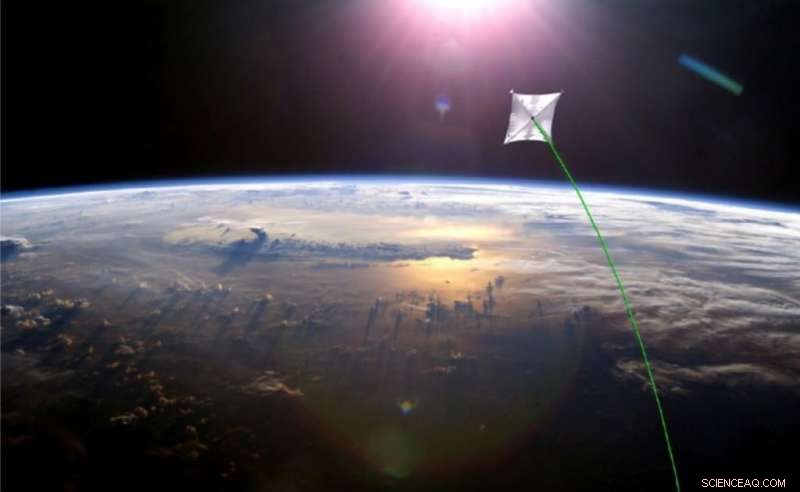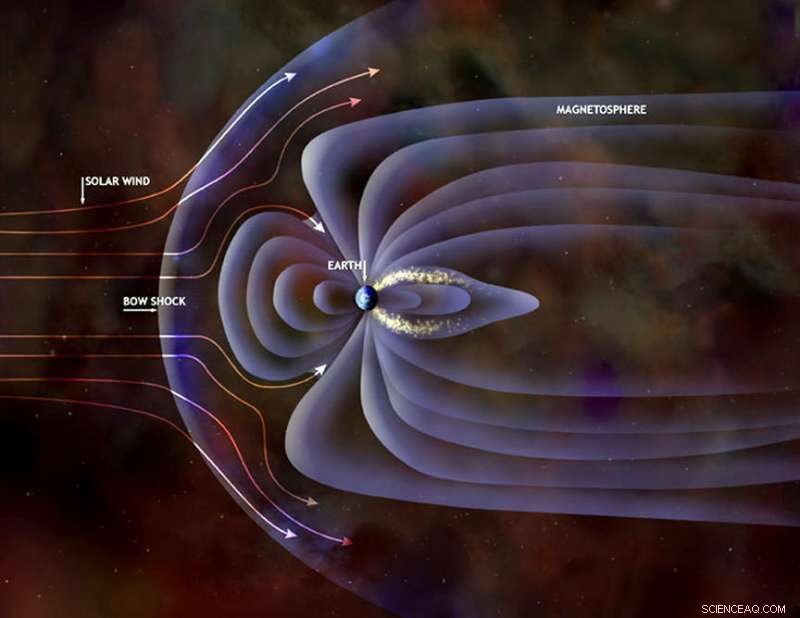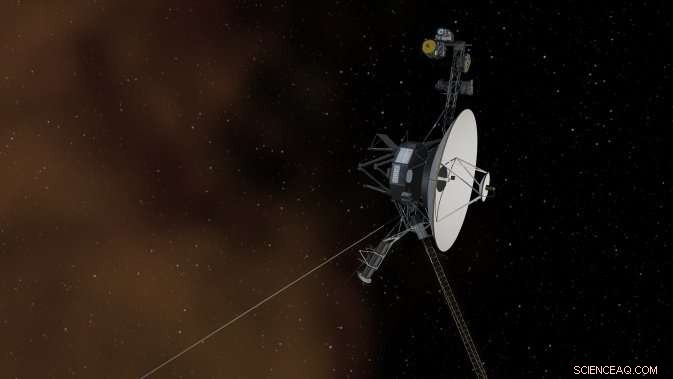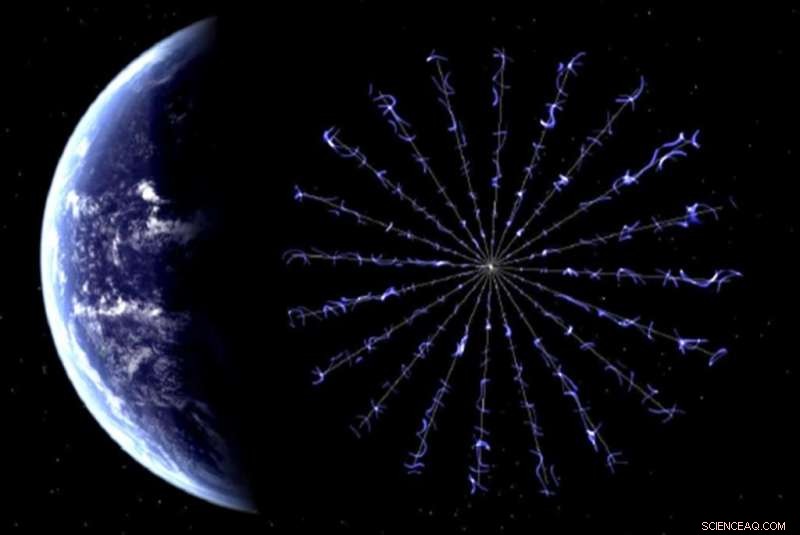
Concepto artístico de una misión de demostración de velas solares que utilizará láseres para la navegación. Crédito:NASA
Todos estamos familiarizados con la idea de las velas solares para explorar el sistema solar, utilizando la ligera presión del sol. Pero hay otro sistema de propulsión que podría aprovechar el poder del sol, velas eléctricas, y es una idea muy interesante.
Hace unas pocas semanas, Abordé una pregunta que alguien tenía sobre mis sistemas de propulsión exóticos favoritos, y recité algunas ideas que me parecen emocionantes:velas solares, cohetes nucleares, motores de iones, etc. Pero hay otro sistema de propulsión que sigue apareciendo, y me olvidé por completo de mencionar, pero es una de las mejores ideas que he escuchado en un tiempo:velas eléctricas.
Como probablemente sabes, una vela solar funciona aprovechando los fotones de luz que emite el sol. Aunque los fotones no tienen masa, tienen impulso, y pueden transferirlo cuando rebotan en una superficie reflectante.
Además de la luz, el sol también expulsa una corriente constante de partículas cargadas:el viento solar. Un equipo de ingenieros de Finlandia, dirigido por el Dr. Pekka Janhunen, ha propuesto construir una vela eléctrica que utilizará estas partículas para transportar naves espaciales al sistema solar.
Para entender cómo funciona esto, Necesitaré introducir algunos conceptos en tu cerebro.
Primero, el sol. Esa bola de radiación mortal en el cielo. Como probablemente sabes, hay un flujo constante de partículas cargadas, principalmente electrones y protones, alejándose del sol en todas direcciones.
Los astrónomos no están del todo seguros de cómo, pero algún mecanismo en la corona del sol, su atmósfera superior, acelera estas partículas a una velocidad de escape. Su velocidad varía de 250 a 750 km / s.
El viento solar se aleja del sol, y hacia el espacio. Vemos sus efectos en los cometas, dándoles sus colas características, y forma una burbuja alrededor del sistema solar conocida como heliosfera. Aquí es donde el viento solar del sol se encuentra con los vientos solares colectivos de las otras estrellas de la Vía Láctea.
De hecho, La nave espacial Voyager de la NASA pasó recientemente por esta región, finalmente abriéndose camino hacia el espacio interestelar.
El viento solar provoca una presión directa, como un viento real, pero es increíblemente débil una fracción de la presión ligera que experimenta una vela solar.
Pero el viento solar está cargado negativamente, y esta es la clave.
Una vela eléctrica funciona enrollando un cable increíblemente delgado, solo 25 micrones de espesor, pero 20 kilómetros de largo. La nave espacial está equipada con paneles solares y un cañón de electrones que solo necesita unos pocos cientos de vatios para funcionar.

Visualización del viento solar que se encuentra con las "defensas" magnéticas de la Tierra conocidas como magnetosfera. Las nubes de plasma que apuntan hacia el sur pueden despegar las capas de la burbuja que mira hacia el Sol y apilarlas en capas en el lado nocturno del planeta (centro, Derecha). Las capas se pueden apretar lo suficiente para reconectarse y entregar electrones solares (destellos amarillos) directamente a la atmósfera superior para crear la aurora. Crédito:JPL
Al disparar electrones al espacio, la nave espacial mantiene un estado de carga altamente positiva. A medida que las partículas cargadas negativamente del sol se encuentran con la correa cargada positivamente, lo "ven" como un gran obstáculo de 100 metros de diámetro, y chocar contra él.
Al impartir su impulso a la correa y la nave espacial, los iones lo aceleran alejándolo del sol.
La cantidad de aceleración es muy débil, pero es la presión constante del sol y puede acumularse durante un largo período de tiempo. Por ejemplo, si una nave espacial de 1000 kg tuviera 100 de estos cables extendiéndose en todas las direcciones, podría recibir una aceleración de 1 mm por segundo por segundo.
En el primer segundo viaja 1 mm, y luego 2 mm en el siguiente segundo, etc. En el transcurso de un año, esta nave espacial podría ir a 30 km / s. Solo para comparar la nave espacial más rápida que existe, Voyager 1 de la NASA, va simplemente a unos 17 km / s. Entonces, mucho mas rápido, definitivamente en una velocidad de escape del sistema solar.
Una de las desventajas del método, actualmente, es que no funcionará dentro de la magnetosfera de la Tierra. Por lo tanto, una nave espacial impulsada por velas eléctricas tendría que ser transportada por un cohete tradicional lejos de la Tierra antes de que pudiera desplegar su vela y dirigirse al espacio profundo.
Estoy seguro de que se está preguntando si este es un viaje de ida para alejarse del sol, pero en realidad no lo es. Al igual que con las velas solares, una vela eléctrica puede pivotar. Dependiendo de qué lado de la vela golpee el viento solar, eleva o baja la órbita de la nave espacial desde el sol.

This artist’s concept shows the Voyager 1 spacecraft entering the space between stars. Interstellar space is dominated by plasma, ionized gas (illustrated here as brownish haze), that was thrown off by giant stars millions of years ago. Crédito:NASA
Strike the sail on one side and you raise its orbit to travel to the outer solar system. But you could also strike the other side and lower its orbit, allowing it to journey down into the inner solar system. It's an incredibly versatile propulsion system, and the sun does all the work.
Although this sounds like science fiction, there are actually some tests in the works. An Estonian prototype satellite was launched back in 2013, but its motor failed to reel out the tether. The Finnish Aalto-1 satellite was launched in June 2017, and one of its experiments is to test out an electric sail.
We should find out if the technique is viable later this year.
It's not just the Finns who are considering this propulsion system. En 2015, NASA announced that they had awarded a Phase II Innovative Advanced Concepts grant to Dr. Pekka Janhunen and his team to explore how this technology could be used to reach the outer solar system in less time than other methods.
The Heliopause Electrostatic Rapid Transit System, or HERTS spacecraft would extend 20 of these electric tethers outward from the center, forming a huge circular electric sail to catch the solar wind. By slowly rotating the spacecraft, the centrifugal forces will stretch the tethers out into this circular shape.
With its positive charge, each tether acts like a huge barrier to the solar wind, giving the spacecraft an effective surface area of 600 square kilometers once it launches from the Earth. As it gets farther, from Earth, aunque, its effective area increases to the equivalent of 1, 200 square km by the time it reaches Jupiter.

Artist’s illustration of NASA’s Heliopause Electrostatic Rapid Transit System. Crédito:NASA
When a solar sail starts to lose power, an electric sail just keeps accelerating. De hecho, it would keep accelerating out past the orbit of Uranus.
If the technology works out, the HERTS mission could reach the heliopause in just 10 years. It took Voyager 1 35 years to reach this distance, 121 astronomical units from the sun.
But what about steering? By changing the voltage on each wire as the spacecraft rotates, you could have the whole sail interact differently on one side or the other to the solar wind. You could steer the whole spacecraft like the sails on a boat.
En septiembre de 2017, a team of researchers with the Finnish Meteorological Institute announced a pretty radical idea for how they might be able to use electric sails to comprehensively explore the asteroid belt.
Instead of a single spacecraft, they proposed building a fleet of 50 separate 5-kg satellites. Each one would reel out its own 20 km-long tether and catch the sun's solar wind. Over the course of a 3-year mission, the spacecraft would travel out to the asteroid belt, and visit several different space rocks. The full fleet would probably be able to explore 300 separate objects.
Each spacecraft would be equipped with a small telescope with only a 40 mm aperture. That's about the size of a spotting scope, or half a pair of binoculars, but it would be enough to resolve features on the surface of an asteroid as small as 100 meters across. They'd also have an infrared spectrometer to be able to determine what minerals each asteroid is made of.

This image depicts the two areas where most of the asteroids in the solar system are found:the asteroid belt between Mars and Jupiter, and the trojans, two groups of asteroids moving ahead of and following Jupiter in its orbit around the sun.
That's a great way to find that $10 trillion asteroid made of solid platinum.
Because the spacecraft would be too small to communicate all the way back to Earth, they'd need to store the data on board, and then transmit everything once they came past our planet 3 years later.
The planetary scientists I've talked to love the idea of being able to survey this many different objects at the same time, and the electric sail idea is one of the most efficient methods to do it.
Según los investigadores, they could do the mission for about $70 million, bringing the cost to analyze each asteroid down to about $240, 000. That would be cheap compared to any other method proposed of studying asteroids.
Space exploration uses traditional chemical rockets because they're known and reliable. Sure they have their shortcomings, but they've taken us across the solar system, to billions of kilometers away from Earth.
But there are other forms of propulsion in the works, like the electric sail. And over the coming decades, we're going to see more and more of these ideas put to the test. A fuel free propulsion system that can carry a spacecraft into the outer reaches of the solar system? Sí, por favor.